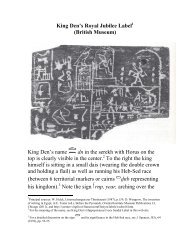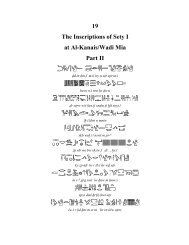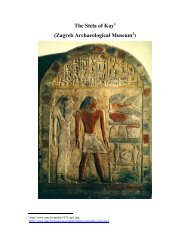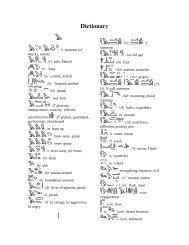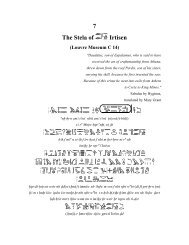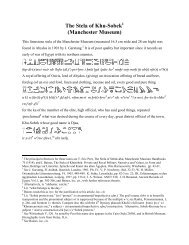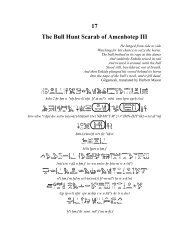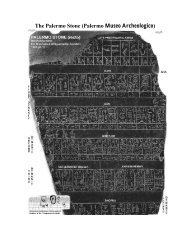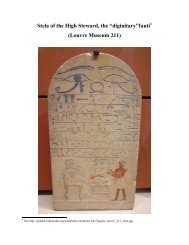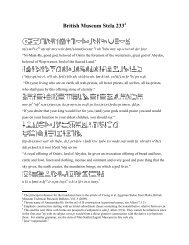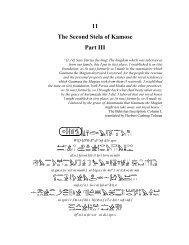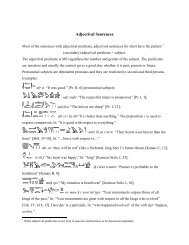9 The Second Stela of Kamose Part I - Middle Egyptian Grammar ...
9 The Second Stela of Kamose Part I - Middle Egyptian Grammar ...
9 The Second Stela of Kamose Part I - Middle Egyptian Grammar ...
You also want an ePaper? Increase the reach of your titles
YUMPU automatically turns print PDFs into web optimized ePapers that Google loves.
9<br />
<strong>The</strong> <strong>Second</strong> <strong>Stela</strong> <strong>of</strong> <strong>Kamose</strong><br />
<strong>Part</strong> I<br />
“[1.11] Says Darius the king: Afterwards there was one man, a Magian,<br />
Gaumata by name; he rose up from Paishiyauvada… he thus deceived<br />
the people; I am Bardiya the son <strong>of</strong> Cyrus brother <strong>of</strong> Cambyses; afterwards<br />
all the people became estranged from Cambyses (and) went over to him,<br />
both Persia and Media and the other provinces; he seized the kingdom…<br />
afterwards Cambyses died by a self-imposed death.<br />
[1.12] Says Darius the king: This kingdom which Gaumata the Magian<br />
took from Cambyses, this kingdom from long ago was (the possession)<br />
<strong>of</strong> our family; afterwards Gaumata the Magian took from Cambyses<br />
both Persia and Media and the other provinces; he seized (the power)<br />
and made it his own possession; he became king.”<br />
<strong>The</strong> Behistun Inscription, Column I,<br />
translated by Herbert Cushing Tolman<br />
smi Xz m Xnw dmi.k tw.k tf.ti r-gs mSa.k<br />
r.k Hns m ir.k wi m wr iw.k m HqA r dbH n.k tA nmt xrt.k n.s<br />
mA sA.k bin mSai m sA.k<br />
nn iwr Hmwt Hwt-wart nn zn ib.sn m Xnw Xt.sn<br />
sDm.t(w) hmhmt nt pAy.i mSa
iw.i mn.kw r pr-Dd-qn ib.i Aw(.w)<br />
di.i mA ippi At Hwrt<br />
wr n rTnw Xz awi xmt qnw m ib.f n(i) xpr.sn n.f<br />
spr.kw r inyt-nt-xnt tw.i DA.kw n.sn r wSd st<br />
ir.n.i pA aHaw sab(.w) wa m-sA wa<br />
di.i HAt Hr Hmw m nAy.i n qnyt Hr aXt Hr irrw<br />
mi wnn bik imw.i n nbw r HAt iri<br />
iw(.i) mi bik iri r HAt.sn<br />
di.i pA mk qn Hr xA(t) r aD<br />
tA DAt m sA.f mi wnn Drtyw Hr Xtt Hr Dat hwt-wart<br />
gmH.n.i Hmwt.f Hr tp Hwt.f Hr nwA m SSdw.sn r mryt<br />
nn zn Xwt.sn mA.sn wi nwA.sn m Srwt iri Hr inb.sn<br />
mi TAw n inHw m Xnw bAb(A)w.sn m Dd Hn pw
m.k wi ii.kw mar zp(y)t m a.i mnx zp.i<br />
wAH imn qn, nn wAH.i tw<br />
nn di.i dgs.k AHt iw nn wi Hr.k<br />
wh m/whA ib.k ir.f aAm Xz<br />
m.k swri.i m irp n kAmw.k m atx n.i aAmw n HAq.i<br />
Xb(A).i st.k Hmst Sa.i mnw.k<br />
grm.n.i Hmwt.k r wnDwt nHm.i tA nt Htri
<strong>The</strong> <strong>Second</strong> <strong>Stela</strong> <strong>of</strong> <strong>Kamose</strong>: <strong>Part</strong> I<br />
smi report<br />
tfi move/force away, drive<br />
back, expel<br />
Hns narrow<br />
dbH ask for, beg<br />
nm rob, steal, seize wrongly<br />
nmt butcher block<br />
iwr conceive (child)<br />
zn open, stir<br />
mn remain<br />
miserable, poor<br />
fleet<br />
ippi Apophis (Hyksos ruler)<br />
At moment<br />
xmt think<br />
Hwrw wretched,<br />
aHaw ships; pA aHaw the<br />
sab equip (ship with weapons)<br />
abA command (ship)<br />
HAt front, prow (<strong>of</strong> a ship)<br />
Hmw steering-oar, rudder<br />
aXi fly<br />
imw ship<br />
xAi measure, probe<br />
Vocabulary<br />
aD/ ad desert edge, margin <strong>of</strong><br />
cultivation<br />
DAt remainder<br />
Dryt bird <strong>of</strong> prey, kite,<br />
sparrow-hawk<br />
Xtt uproot/pluck plants<br />
gmH catch sight <strong>of</strong><br />
nwA, nw<br />
peek, glimpse, peer<br />
cruel<br />
ravage<br />
sSd window, opening<br />
Hwt enclosure<br />
mryt bank, shore<br />
Srt nose, nostril<br />
inb wall<br />
TA young, nestling<br />
Hn attack<br />
zpyt remainder, remnant<br />
dgs walk, tread<br />
whi fail, miss, escape<br />
irp wine<br />
whA ib heartless,<br />
kAmw vineyard, orchard<br />
atx strain mash, press wine<br />
xbA destroy, lay waste,
st Hmst rest house<br />
Sa cut <strong>of</strong>f, cut down (trees)<br />
mnw trees, plantation<br />
wnDwt hold (<strong>of</strong> ship)<br />
Htr (span <strong>of</strong>) horses
<strong>The</strong> <strong>Second</strong> <strong>Stela</strong> <strong>of</strong> <strong>Kamose</strong>: <strong>Part</strong> I<br />
<strong>Grammar</strong> Points<br />
<strong>The</strong> second stela <strong>of</strong> <strong>Kamose</strong>, recording his northern campaign was discovered in 1954 in<br />
Karnak. It was used as the base <strong>of</strong> a statue <strong>of</strong> Ramesses II.<br />
One <strong>of</strong> the principal issues that a translator <strong>of</strong> the stela faces is the identification <strong>of</strong> the<br />
various verb forms used in the text. 1 In particular, at many instances the translator needs to<br />
carefully evaluate whether <strong>Kamose</strong> refers to the past, narrates the present, or makes future<br />
threats or prophecies. To attain this goal it is important to distinguish which part <strong>of</strong> the<br />
text is <strong>Kamose</strong>’s own speech and which is his narrative <strong>of</strong> the events.<br />
smi Xz m Xnw dmi.k tw.k tf.ti r-gs mSa.k<br />
<strong>The</strong> stela starts with an adverb clause setting the scene in Avaris. Depending on<br />
interpretation, the noun smi can mean “report” and also “reputation.” <strong>The</strong> Hykosos capital<br />
is referred to as dmi “town” and the attached suffix pronoun .k “your” refers to the Hyksos<br />
ruler, Aauserra Apophis. <strong>The</strong> abrupt beginning which may actually be an incomplete<br />
sentence points to the fact that this stela is the continuation <strong>of</strong> a previous yet undiscovered<br />
stela. 2<br />
In the next clause the subject form <strong>of</strong> the 2MS personal pronoun tw.k is the topicalized<br />
subject <strong>of</strong> a subject-stative construction involving the verb tfi “move/force away, driven<br />
back, expel.” Since this is a transitive verb, the stative expresses passive voice. <strong>The</strong> usual<br />
meaning <strong>of</strong> the compound preposition r-gs “beside,” lit. “at the side <strong>of</strong>,” needs to be<br />
mildly upgraded to “in the company/presence <strong>of</strong>.”<br />
r.k Hns m ir.k wi m wr iw.k m HqA r dbH n.k tA nmt xrt.k n.s<br />
<strong>The</strong>re are a few nfr Hr constructions that use the adjective Hns “narrow” such as Hns ib<br />
“narrow minded” and Hns a “stingy,” lit. “narrow <strong>of</strong> hand.” With a bit <strong>of</strong> push, the noun<br />
1 For a very detailed account, see Smith and Smith (III. <strong>The</strong> Tenses in the <strong>Kamose</strong> Texts) in the<br />
Bibliography at the end <strong>of</strong> the <strong>Grammar</strong> Points: <strong>Part</strong> III.<br />
2 See Habachi in the Bibliography.
phrase r.k Hns can then be translated as “mean speech.” (r “speech, utterance” can also be<br />
interpreted as “authority (through the mouth)” and so this phrase may express restricted<br />
authority.) This is the subject <strong>of</strong> the first adverbial clause. In the adverbial predicate the<br />
object <strong>of</strong> the preposition m is the perfective relative form <strong>of</strong> iri “make” (and not the<br />
infinitive ir(t)) with suffixed pronominal subject .k and object wi “me.” <strong>The</strong> preposition m<br />
itself here carries the meaning “with, through, by” and the literal meaning is: “through<br />
which you make me.” Note that Habachi 3 translates r.k Hns as an AB nominal sentence:<br />
“Your speech is mean” and continues with a circumstantial clause: “when you make me<br />
as…” But the use <strong>of</strong> the AB nominal construction is very restricted in <strong>Middle</strong> <strong>Egyptian</strong><br />
and does not fit in this situation.<br />
<strong>Kamose</strong>’s first resentment is that Apophis (probably in a previous correspondence) refers<br />
to him as wr “chief(tain)” (using m <strong>of</strong> predication), while he calls himself HqA “ruler”<br />
(introduced by the adverb clause marker iw and followed by another m <strong>of</strong> predication).<br />
<strong>The</strong> contrast can be brought out in translation by inserting “while” between the two<br />
clauses. In the unmarked relative clause that follows the introductory iw.k is omitted<br />
either because it has just been spelled out or because the clause immediately follows the<br />
antecedent HqA. 4 <strong>The</strong> predicate uses the r + infinitive construction with the verb<br />
dbH “ask for, beg” expressing the future fate <strong>of</strong> the ruler <strong>of</strong> Avaris, lit. “who<br />
is toward begging.” <strong>The</strong> object (following the dative n.k “for you/yourself”) is the noun<br />
phrase tA nmt. Clearly, nmt is a noun here; its meaning, however, is subject to two<br />
interpretations. First, it could be a perfective passive participle derived from the verb<br />
nm “rob, steal, seize wrongly,” lit. “what is (wrongly) seized.” This would<br />
emphasize that Apophis is an aggressor <strong>of</strong> a foreign land. <strong>Second</strong>, with the right<br />
determinative it can simply mean the “butcher block” awaiting for the Hyksos ruler. In<br />
either case, tA nmt is the antecedent <strong>of</strong> the following clause which contains the (feminine)<br />
perfective relative form <strong>of</strong> xr “fall.” <strong>The</strong> preposition n (with suffix .s referring back to the<br />
antecedent) can be translated as “because <strong>of</strong>” or “through.”<br />
3 Op. cit.<br />
4 See Allen (15.10.2).
mA sA.k bin mSa.i m sA.k<br />
<strong>The</strong> prospective/subjunctive sDm.f <strong>of</strong> the verb mAA with subject sA.k and object bin<br />
expresses another future threat <strong>of</strong> <strong>Kamose</strong>. Since the spelling <strong>of</strong> bin as a noun and as an<br />
adjective-verb is the same, less likely and with quite different meaning, bin can also be<br />
viewed as an adjective modifying sA.k: “your evil back.” In this case, it is the object <strong>of</strong> the<br />
passive verb form mA. In either case, the second clause describes the corresponding<br />
adverbial circumstance, it can be introduced by “when” or “since.”<br />
nn iwr Hmwt Hwt-wart nn zn ib.sn m Xnw Xt.sn<br />
<strong>The</strong> two clauses here contain the most typical negation <strong>of</strong> the prospective/subjunctive<br />
sDm.f and should be translated as future “will not.” <strong>The</strong> rope determinative is usually<br />
replaced by the door determinative in the usual spelling <strong>of</strong> the verb zn “open,”<br />
and this is the first part <strong>of</strong> the phrase zn ib “open the heart” with a clear sensual rather than<br />
physical meaning. It is interesting to compare this sentence with the following:<br />
wp.t(w).sn m msit. 5<br />
… zt-Hmwt 20 m nfrwt…nti n(i)<br />
sDm.t(w) hmhmt nt pAy.i mSa<br />
This is an adverb clause employing the passive form <strong>of</strong> the concomitant<br />
circumstantial/imperfective <strong>of</strong> the verb sDm “hear” followed by a long object. It provides<br />
the reason why the women <strong>of</strong> Avaris will not be able to conceive, and can be introduced<br />
by “when.” Note the late form <strong>of</strong> the possessive pronoun.<br />
iw.i mn.kw r pr-Dd-qn ib.i Aw(.w)<br />
This is a turning point in the text and <strong>Kamose</strong>’s narrative starts. <strong>The</strong> threats suddenly stop,<br />
and two subject-stative constructions describe <strong>Kamose</strong>’s whereabouts (in the<br />
unfortunately unknown location pr-Dd-kn 6 ) and his state <strong>of</strong> mind. <strong>The</strong> verb<br />
5 [Westcar, 5, 9, f].
mn “remain” should be translated as “moor.”<br />
di.i mA ippi At Hwrt<br />
wr n rTnw Xz awi xmt qnw m ib.f n(i) xpr.sn n.f<br />
A rdi + prospective/subjunctive sDm.f construction is employed here (with rdi in<br />
indicative/perfective form, with base stem di) to turn <strong>Kamose</strong>’s attention back to<br />
ippi “Apophis,” lit. I caused that Apophis sees…” (Note that Hyksos ruler is<br />
referred here in 3MS as opposed to the previous 2MS.) In the following AB apposition A<br />
is the indirect genitive wr n rTnw once again pointing out that the Apophis does not belong<br />
to Egypt, 7 and B is nfr Hr construction Xz awi “weak/feeble <strong>of</strong> arms” stating that he unable<br />
to govern. <strong>The</strong> passage that follows further details this inability: <strong>The</strong> active participle <strong>of</strong><br />
the 3-lit. verb xmt “think” has object qnw m ib.f in which the determinative<br />
for abstract concepts indicates that the adjective-verb qni here is used as a noun and in<br />
plural it should mean “brave things/deeds.” Finally, in the last unmarked relative clause<br />
the suffix pronoun .sn <strong>of</strong> the negated indicative/perfective sDm.f (the negative counterpart<br />
<strong>of</strong> the circumstantial sDm.n.f /perfect) <strong>of</strong> the verb xpr refers to the plural qnw and the<br />
clause be translated using the word “never.”<br />
spr.kw r inyt-nt-xnt tw.i DA.kw n.sn r wSd st<br />
<strong>The</strong> stative <strong>of</strong> the verb spr “arrive” and the following subject-stative construction once<br />
again brings the narrative back to <strong>Kamose</strong>’s whereabouts. Although the determinative <strong>of</strong><br />
inyt is the sun not the town inyt-nt-xnt must be a locality. As the name suggests it<br />
may be a well-frequented depot/landing place to sail upstream. 8 <strong>The</strong> next clause contains a<br />
subject-stative construction (with topicalized subject form <strong>of</strong> the 1MS personal pronoun<br />
tw.i) and due to the lack <strong>of</strong> an antecedent <strong>of</strong> the prepositional phrase n.sn the suffix<br />
6<br />
Smith and Smith take the literal meaning and translate this as the “House <strong>of</strong> the Braggart.”<br />
7<br />
Retjenu is the present-day Lebanon.<br />
8<br />
Once again, this is the-Ferry-<strong>of</strong>-going-upstream <strong>of</strong> Smith and Smith.
pronoun .sn may refer to the inhabitants <strong>of</strong> the town, <strong>Kamose</strong>’s own navy or the people in<br />
Avaris. <strong>The</strong> object <strong>of</strong> the infinitive <strong>of</strong> the 3-lit. verb wSd, the dependent pronoun st, once<br />
again has no antecedent and we can just guess that it either refers to the town-folks again<br />
or to the subject <strong>of</strong> <strong>Kamose</strong>’s investigation/questioning in general.<br />
ir.n.i pA aHaw sab(.w) wa m-sA wa<br />
di.i HAt Hr Hmw m nAy.i n qnyt Hr aXt Hr irrw<br />
mi wnn bik imw.i n nbw r HAt iri<br />
iw(.i) mi bik iri r HAt.sn<br />
This passage describes the battle-array <strong>of</strong> <strong>Kamose</strong>’s navy. <strong>The</strong> circumstantial sDm.n.f<br />
/perfect <strong>of</strong> the verb iri “make, put” starts the first clause and the phrase wa m-sA wa clearly<br />
indicates that <strong>Kamose</strong> lined up his ships one after the other. (Note that aHaw “ship(s)” with<br />
the definite article pA means “fleet.”) <strong>The</strong> difficulty comes here in interpreting the verb in<br />
3MS stative sab(.w) in the middle. On the one hand, assigning only b to the jabiru (in<br />
group writing bA can stand only for b) it can be the verb sab “deploy, equip<br />
(ship with weapons).” Less likely, it can also be the (not attested) causative <strong>of</strong> the verb<br />
abA “command (ship).” In either case the meaning <strong>of</strong> the sentence is<br />
clear.<br />
Next, the resulting prow to steering-oar formation is expressed by the concomitant<br />
circumstantial/imperfective sDm.f <strong>of</strong> the verb rdi. Alternatively, the expression rdi HAt can<br />
also be translated as “take the lead.” <strong>The</strong> collective noun (phrase) qnyt (nsw) “the braves<br />
(<strong>of</strong> the king)” can refer to the king’s body-guard or the group <strong>of</strong> most valiant warriors, the<br />
king’s elite force to spearhead the attack. <strong>The</strong> Hr + infinitive construction uses the verb<br />
aXi “fly” (in a figurative sense), and irrw is a well-attested form<br />
<strong>of</strong> the usual spelling <strong>of</strong> itrw “river.” Apart from the topicalized
metaphoric adverbial phrase mi wnn bik the next clause is adverbial: imw.i n nbw r HAt iri<br />
in which the subject is a phrase that can be rendered as “flagship <strong>of</strong> gold.” This clause<br />
itself is the theme (since the flagship must be at the head <strong>of</strong> the fleet). In the topicalization<br />
(which should normally be at the end) the object <strong>of</strong> the preposition mi is the noun clause<br />
wnn bik. <strong>The</strong> latter is the rheme with the nonattributive imperfective relative form <strong>of</strong> wnn,<br />
thereby emphatic. <strong>The</strong> cleft sentence construction: “(It was) like a falcon (that) my<br />
flagship <strong>of</strong> gold…” can bring out the emphasis.<br />
<strong>The</strong> last simple adverb clause reiterates that <strong>Kamose</strong> is spearheading the battle formation<br />
with the last metaphor repeated. <strong>The</strong> scroll determinative in the otherwise doubtful<br />
reading <strong>of</strong> iri makes Smith and Smith 9 suggest that this is the second part <strong>of</strong> the well<br />
known epithet for a king: bik nTri “divine falcon”<br />
di.i pA mk qn Hr xA(t) r aD<br />
tA DAt m sA.f mi wnn Drtyw Hr Xtt Hr Dat hwt-wart<br />
As its context indicates, this sentence can still be considered as part <strong>of</strong> the previous<br />
passage, therefore the verb rdi is in concomitant circumstantial/imperfective sDm.f. Its<br />
object, the “mk-ship” (introduced by the definite article pA), is not attested before the<br />
linguistic evolution <strong>of</strong> the Amarna Period 10 ; in any case, the attached adjective qn claims it<br />
to be a “mighty” (possibly a transport) ship. <strong>The</strong> Hr + infinitive construction describes the<br />
(continual) task <strong>of</strong> this ship. <strong>The</strong> object aD/ ad <strong>of</strong> the verb xAi “measure”<br />
means “desert edge, margin <strong>of</strong> cultivation” so that the phrase in question can be<br />
interpreted to sound/probe/investigate or even thrust the desert edge.<br />
<strong>The</strong> adverb clause specifies that DAt “the remainder” <strong>of</strong> the fleet (indicated by the ship<br />
determinative) is behind the mk-ship, the latter being referred to by the suffix pronoun .f.<br />
Based on the parallel between mi wnn bik above and mi wnn Drtiw, the<br />
noun Drtyw is probably a variant spelling <strong>of</strong> Dryt “bird <strong>of</strong> prey,<br />
9 Op. cit.<br />
10 [Davies, Amarna VI, 21, 12].
carrion bird,” a carnivorous, scavenger bird in general. <strong>The</strong> 2ae-gem. verb Xtt<br />
“uproot/pluck plants,” or “prey” is in a Hr + infinitive construction, and the locality, the<br />
Dat <strong>of</strong> Avaris, at which this is happening can be the “plateaux” in the area surrounding<br />
Avaris.<br />
gmH.n.i Hmwt.f Hr tp Hwt.f Hr nwA m SSdw.sn r mryt<br />
nn zn Xwt.sn mA.sn wi nwA.sn m Srwt iri Hr inb.sn<br />
mi TAw n inHw m Xnw bAb(A)w.sn m Dd Hn pw<br />
This passage describes how <strong>Kamose</strong> with pride and the women <strong>of</strong> Apophis with awe were<br />
watching each other with the fleet passing by. <strong>The</strong> action starts with the circumstantial<br />
sDm.n.f /perfect <strong>of</strong> the verb gmH “catch sight <strong>of</strong>.” <strong>The</strong> masculine singular<br />
suffix pronouns .f refers to Apophis. <strong>The</strong> Hr + infinitive construction is used to describe<br />
the corresponding action (in progress) <strong>of</strong> the women, where the verb nwA is<br />
an earlier form <strong>of</strong> nw having various meanings connected to “see, look”<br />
such as “peek, glimpse, peer.” SSd is an unusual spelling <strong>of</strong> sSd “window,<br />
opening” or “embrasure.” 11<br />
As opposed to the previous appearance <strong>of</strong> the verb zn “open” in his threats and boasts,<br />
here <strong>Kamose</strong> describes the real situation. <strong>The</strong>refore the verbs that follow should refer to<br />
the past. Accepting this, in the following the adverb clause nn zn is a negated infinitive<br />
“not stirring” (less likely, negated indicative/perfective sDm.f “did not stir” with nn<br />
playing the role <strong>of</strong> ni).<br />
Although it uses the base stem, mA.sn is probably the infinitive <strong>of</strong> the verb mAA with the<br />
suffix pronoun .sn as its subject. (<strong>The</strong> emphatic construction with mA.sn as emphasized<br />
adverb clause: “it is when they saw me they did dot stir” is less likely because it is the<br />
main clause nn zn Xwt.sn that contains the new information, therefore it is the rheme.) <strong>The</strong><br />
11 For an explanation and detailed analysis <strong>of</strong> this term see Smith and Smith, op. cit.
same holds for the next adverb clause. <strong>The</strong> description <strong>of</strong> the frightened Avaris women is<br />
made quite vivid using the expression nwA m Srt “peeking with the nose/nostril,” and one<br />
may well imagine them in a prostrated position on the ro<strong>of</strong> having their noses on the same<br />
level as their eyes. <strong>The</strong> animal inH living in a hole is unknown, probably a kind<br />
<strong>of</strong> lizard or mouse. Habachi 12 interpreted the subject <strong>of</strong> the m + infinitive construction as<br />
the women who in an A pw nominal sentence acknowledge <strong>Kamose</strong>’s presence as being<br />
an attack. In view <strong>of</strong> the fact that the next passage is clearly <strong>Kamose</strong>’s speech, Smith and<br />
Smith 13 argued that Habachi’s view would result in an abrupt change in the flow <strong>of</strong> the<br />
text and therefore they interpret m Dd as <strong>Kamose</strong>’s own with (dependent pronominal)<br />
subject wi (actually appearing a bit before): “as I said: This is the attack.” This requires<br />
interpreting nwA.sn as a circumstantial clause: “as they were looking out…”<br />
m.k wi ii.kw mar zp(y)t m a.i mnx zp.i<br />
In the first <strong>of</strong> this sequence <strong>of</strong> four clauses the subject-stative construction with the verb ii<br />
“come” is used to call Apophis’ attention to <strong>Kamose</strong>’s presence. <strong>The</strong> adjective mar here<br />
carries the seated man determinative, so it must be used as a noun “successful man.”<br />
Adjectival quality with first person pronominal subject is expressed by a nominal<br />
construction ink mar, so may assume that here the subject, <strong>Kamose</strong> himself, being the<br />
same as in the previous clause, is suppressed. In the third, adverbial clause is a variant<br />
spelling <strong>of</strong> zpyt “remainder, remnant.” What is left over is a reference to the<br />
part <strong>of</strong> Egypt that <strong>Kamose</strong> rules over. Finally, the last clause has an adjectival predicate<br />
mnx, and zp should be understood as “situation, condition, venture.”<br />
wAH imn qn, nn wAH.i tw<br />
nn di.i dgs.k AHt iw nn wi Hr.k<br />
12 Op. cit.<br />
13 Op. cit.
wh m/whA ib.k ir.f aAm Xz<br />
This sentence contains a typical oath expressed by the initial nonattributive relative form<br />
<strong>of</strong> wAH “endure.” As such it is usually followed by a god’s or a king’s name. In our case it<br />
is Amun with the attached adjective qn used as a noun. In this construction a main clause<br />
always follows, which, in our case, contains the negated prospective/subjunctive sDm.f <strong>of</strong><br />
wAH “leave (alone), set aside, ignore” expressing negated future. Another main clause<br />
further details this. It also contains the negated prospective/subjunctive <strong>of</strong> rdi “let.” This,<br />
in turn, is part <strong>of</strong> a causative rdi sDm.f construction with the verb dgs<br />
“walk, tread” also in the prospective/subjunctive. This along with the attached negated<br />
adverb clause (which can be translated using “unless”) challenges Apophis to come out to<br />
the open and face him.<br />
<strong>The</strong>re is a scribal error in the phrase whm ib.k, and it can be corrected in two ways. First,<br />
if m is swapped with the evil bird determinative, the new reading is wh m ib.k, with the<br />
verb whi meaning “fail.” In this case the sentence has an omitted subject .k (Apophis,<br />
repeated several times previously), and his “epithet” aAm Xz is repeated at the end <strong>of</strong> the<br />
sentence for emphasis. <strong>The</strong> verb form <strong>of</strong> whi is subject to interpretation. It can be<br />
indicative/perfective sDm.f (instead <strong>of</strong> transitive circumstantialsDm.n.f /perfect) concluding<br />
the failure <strong>of</strong> Apophis, or prospective/subjunctive sDm.f, expressing <strong>Kamose</strong>’s wish that<br />
the vile Asiatic will fail. (An emphatic construction involving a nonattributive relative<br />
form does not sound probable since it would emphasize the adverbial phrase m ib.k : “it is<br />
in your heart/mind that you failed.) <strong>Second</strong>, less likely (since this error is repeated below),<br />
whA ib is a well-known phrase meaning “heartless, cruel,” lit. “wicked <strong>of</strong> heart” and it may<br />
be possible that the scribe (or the stone carver) accidentally replaced A with m. In this case<br />
this clause is adverbial with the adverb ir.f also playing a role <strong>of</strong> emphasis.<br />
m.k swri.i m irp n kAmw.k m atx n.i aAmw n HAq.i<br />
Allen interprets the verb form <strong>of</strong> swri “drink” (introduced here with the particle m.k with<br />
meaning <strong>of</strong> intention) as prospective/subjunctive sDm.f, lit. “I intend to drink…” 14 Due to<br />
the unusual details <strong>Kamose</strong> provides, however, here and below it is equally likely that the<br />
14 Allen (19.6).
indicative/perfective sDm.f is used. This verb form plays the role <strong>of</strong> the transitive<br />
circumstantial sDm.n.f /perfect, and describes actual events. This choice <strong>of</strong> the verb<br />
form decides whether this passage is part <strong>of</strong> <strong>Kamose</strong>’s speech or his narrative. 15<br />
<strong>The</strong> preposition m governs a noun clause containing the nonattributive relative form <strong>of</strong> the<br />
verb atx “press (wine).” Finally, the subject is the indirect genitive aAmw n HAq.i “my<br />
captured prisoners” in which HAq is a noun meaning “plunder.”<br />
xb(A).i st.k Hmst Sa.i mnw.k<br />
grm.n.i Hmwt.k r wnDwt nHm.i tA nt Htri<br />
Following the previous passage, xbA “destroy, lay waste” and Sa “cut down” are<br />
interpreted as indicative/perfective or intentional prospective/subjunctive sDm.f .<strong>The</strong> verb<br />
form then suddenly changes to circumstantial sDm.n.f /perfect meaning concrete<br />
completed action. Unfortunately the word grm is attested only here. Based on the essence<br />
<strong>of</strong> the whole clause a good guess would be “deposit, assign.” With this, nHm “take away,<br />
carry <strong>of</strong>f” is indicative/perfective sDm.f (instead <strong>of</strong> the previous transitive circumstantial<br />
sDm.n.f /perfect). Finally, tA nt Htri could mean “horses” or “chariotry” doubtless related to<br />
Htr “(span <strong>of</strong>) horses.”<br />
15 Once again, see the discussion in Smith and Smith, op. cit.



